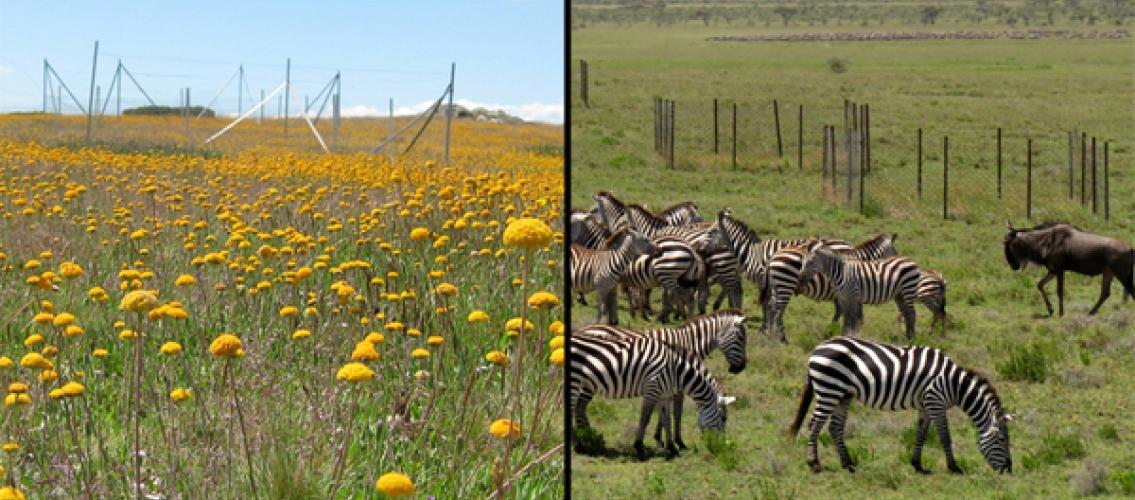
Photo credits:
Left: Jos Moore, University of Melbourne (Australia)/Monash University (Australia)
Right: T. Michael Anderson and T. Morrison
Human activities, such as farming and burning fossil fuels, have more than doubled the amount of nitrogen and phosphorus, entering the earth’s ecosystems. Eutrophication, the ecosystem’s response to the addition of artificial or natural nutrients can result in dramatic changes. In aquatic ecosystems, eutrophication can result in a “bloom” of algae as a result of nitrates or phosphates being washed into the system from a fertilized field. Our understanding of the impacts in terrestrial systems are much more limited.
An international collaborative of scientists have developed the Nutrient Network, or NutNet (http://nutnet.org), which includes researchers at more than 75 sites across North and South America, Europe, Australia, Asia, and Africa to understand the impacts of nutrient additions on global grassland ecosystems. In addition, they are studying whetehr herbivores can lessen the effects of eutrophication by consuming the fast growing plants. The NutNet project enables collaborative research that will advance knowledge about how ecosystems respond to global ecological changes.
Associate Professor Eric Seabloom, an MSI Principal Investigator in the Department of Ecology, Evolution, and Behavior (EEB), and his University of Minnesota colleagues, Associate Professor Elizabeth Borer and Dr. Eric Lind (both also in EEB) coordinate the NutNet collaboration. The researchers use MSI resources to run data-processing scripts and to host the mySQL database for the global experiment collaboration. They have also used MSI nodes for retrieving and processing data-intensive projects such as sub-daily weather data for all the NutNet sites over multiple years. They are planning to further automate data handling and quality control, develop advanced data metadata documentation, and develop web-based database capabilities.
Seabloom and his colleagues recently published two letters in the prestigious journal Nature that demonstrate that nutrient addition causes a loss of species diversity and that lower diversity grasslands become less stable. The news isn’t all-bad though; herbivores can reduce the negative effects of fertilization on diversity by consuming plants and increasing light availability.
- Borer, Elizabeth T., Eric W. Seabloom, Daniel S. Gruner, W. Stan Harpole, Helmut Hillebrand, Eric M. Lind, Peter B. Adler, et al. 2014. Herbivores and nutrients control grass. 9 March 2014, published online ahead of print.
- Hautier, Yann, Eric W. Seabloom, Elizabeth T. Borer, Peter B. Adler, W. Stan Harpole, Helmut Hillebrand, Eric M. Lind, et al. 2014. Eutrophication weakens stabilizing effects of diversity in natural grasslands. Nature. 16 February 2014, published online ahead of print.
Image description: Left: Spring wildflowers with Nutrient Network fences, in the mountains of southeastern Australia. Right: Zebras and wildebeest graze near experimental enclosures in Tanzania, East Africa. (Photos and descriptions from National Science Foundation Discoveries website, “Herbivores + light = more plant biodiversity in fertilized grasslands,” March 10, 2014, downloaded April 4, 2014.)
posted on April 16, 2014